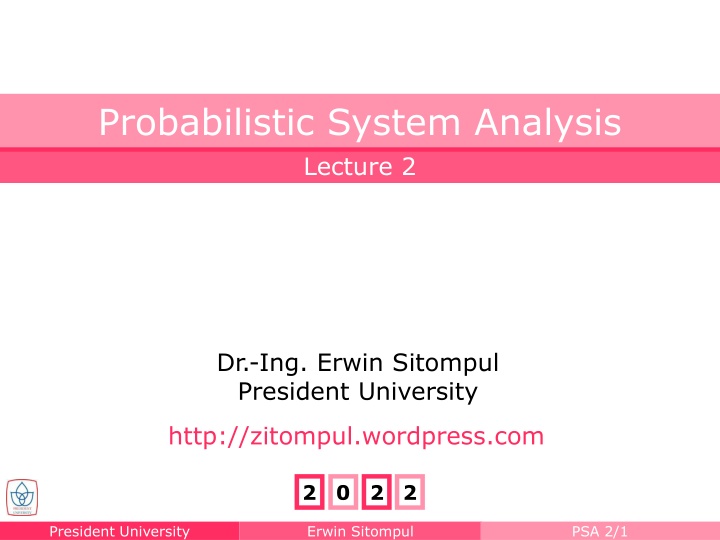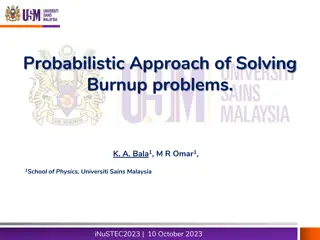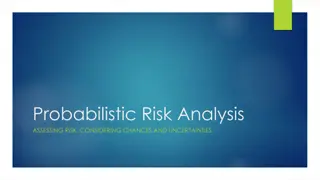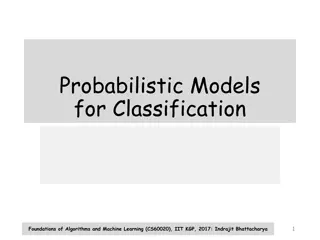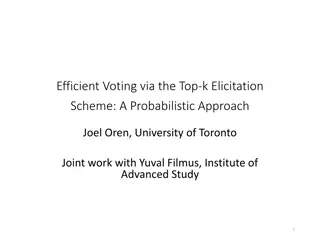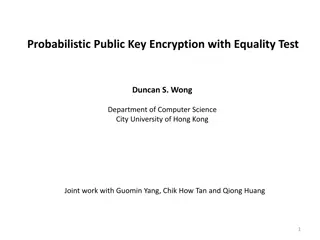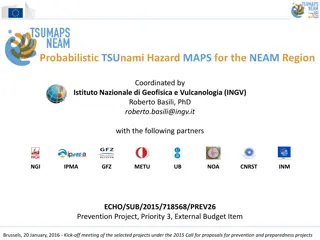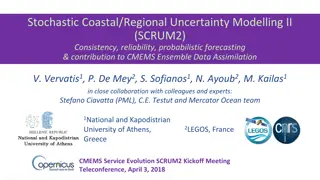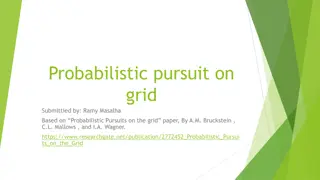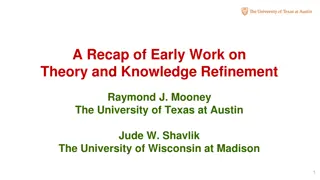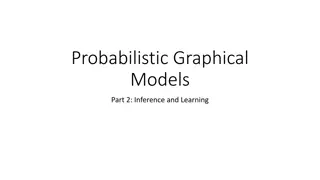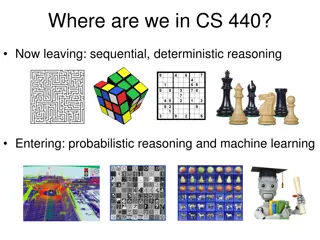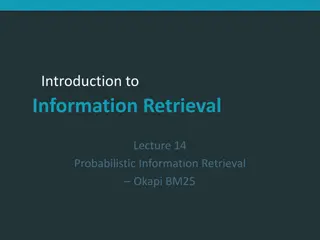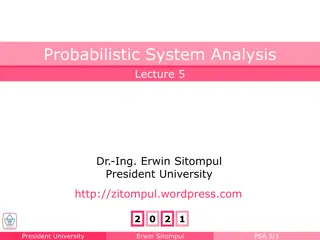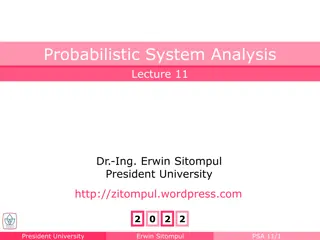Probabilistic System Analysis
Dr. Erwin Sitompul presents a lecture on Probabilistic System Analysis at University. Explore insights and knowledge on this topic through his expertise and guidance. Visit the University's website for more information and valuable resources.
Download Presentation

Please find below an Image/Link to download the presentation.
The content on the website is provided AS IS for your information and personal use only. It may not be sold, licensed, or shared on other websites without obtaining consent from the author.If you encounter any issues during the download, it is possible that the publisher has removed the file from their server.
You are allowed to download the files provided on this website for personal or commercial use, subject to the condition that they are used lawfully. All files are the property of their respective owners.
The content on the website is provided AS IS for your information and personal use only. It may not be sold, licensed, or shared on other websites without obtaining consent from the author.
E N D
Presentation Transcript
Probabilistic System Analysis Lecture 2 Dr.-Ing. Erwin Sitompul President University http://zitompul.wordpress.com 2 0 2 2 President University Erwin Sitompul PSA 2/1
Chapter 2.3 Counting Sample Points Combination In many problems we are interested in the number of ways of selecting r objects from n without regard to order. These selections are called combinations. The number of combinations of n distinct objects taken r at a time is ! !( )! r n r n = C n r A young boy asks his mother to get five game-boy cartridges from his collection of 10 arcade and 5 sport games. How many ways are there that his mother will get 3 arcade and 2 sports games, respectively? The number of ways of selecting 3 arcade games is 10C3. The number of ways of selecting 2 sports games is 5C2. Using the multiplication rule, 10! 5! = = 1200 ways C C 10 3 5 2 3!(10 3)! 2!(5 2)! President University Erwin Sitompul PSA 2/2
Chapter 2.4 Probability of an Event Probability of an Event The likelihood of the occurrence of an event resulting from such a statistical experiment is evaluated by means of a set of real numbers called weights or probabilities ranging from 0 to 1. The probability of an event A is the sum of the weights of all sample points in A. Therefore, 0 ( ) 1, ( ) 0, ( ) P A P P S = Furthermore, if A1, A2, A3, ... is a sequence of mutually exclusive events, then ( ) ( ) ( P A A A P A P A = + = 1 + + ) ( ) P A 1 2 3 1 2 3 If an experiment can result in any one of N different equally likely outcomes, and if exactly n of these outcomes correspond to event A, then the probability of event A is n P A N = ( ) President University Erwin Sitompul PSA 2/3
Chapter 2.4 Probability of an Event Probability of an Event A coin is tossed twice. What is the probability that at least one head occurs? = { , , , } S HH HT TH TT Sample space of the experiment, 4 events = { , , } A HH HT TH Events of interest, at least one head occurs 3 4 ( ) P A = President University Erwin Sitompul PSA 2/4
Chapter 2.4 Probability of an Event Probability of an Event A dice is loaded in such a way that an even number is twice as likely to occur as an odd number. If E is the event that a number less than 4 occurs on a single toss of the dice, find P(E). S = = = {1,2,3,4,5,6} (even) 2 9 P E = {1,2,3} (odd) 1 9 P ( ) P E = 1 9 2 9 1 9 + + = 4 9 As the last example, let A be the event that an even number turns up and let B be the event that a number divisible by 3 occurs. Find P(A B) and P(A B). A = = = {2,4,6} {2,3,4,6} A B ( ) 7 9 P A B = B = = {6} A B {3,6} ( ) 2 9 P A B President University Erwin Sitompul PSA 2/5
Chapter 2.5 Additive Rules Additive Rules If A and B are any two events, then ( ) ( ) P A B P A = S + ( ) P B ( ) P A B A A B B A B If A and B are mutually exclusive, then ( ) ( ) P A B P A = + S ( ) P B A B A B For three events A, B, and C, ( ( P A = + + ) ( ) ) B ( ) P B P A ( ) P C P A B C P A + ( ) ( ) ( ?Can you prove using Venn diagram? ) C P B C P A B C President University Erwin Sitompul PSA 2/6
Chapter 2.5 Additive Rules Additive Rules The probability of John to be hired by company A is 0.8, and the probability that he gets an offer from company B is 0.6. If, on the other hand he believes that the probability that he will get offers from both companies is 0.5, what is the probability that he will get at least one offer from these two companies? = + = = 0.8 0.6 0.5 + ( ) ( ) P A ( ) P B ( ) 0.9 P A B P A B What is the probability of getting a total of 7 or 11 when a pair of fair dice are tossed? Let A be the event that 7 occurs and B the event that 11 comes up. The events A and B are mutually exclusive, since a total of 7 and 11 cannot both occur on the same toss. Therefore, 6 2 36 36 2 9 = = + = + ( ) ( ) P A ( ) P B P A B President University Erwin Sitompul PSA 2/7
Chapter 2.5 Additive Rules Additive Rules If A and A are complementary events, means A A = and A A = S,then ( ) ( ) 1 P A P A + = The probabilities that an automobile mechanic will service 3, 4, 5, 6, 7, or 8 or more cars on any given workday are, respectively, 0.12, 0.19, 0.28, 0.24, 0.10, and 0.07. What is the probability that he will service at least 5 cars on his next day at work? Let E be the event that at least 5 cars are serviced, then E is the event that fewer than 5 cars are serviced. P E = + = P E = 1 0.31 = 0.69 = ( ) 0.12 0.19 0.31 ( ) P E 1 ( ) President University Erwin Sitompul PSA 2/8
Chapter 2.5 Additive Rules Exercise: Additive Rules A retail shop accepts either BNI or Mandiri credit cards. A total of 24% of its customers carry BNI credit cards, while 64% Mandiri credit cards. 11% carry both cards. What percentage of the customers must pay cash in the retail shop? PSA 2/9 Ans Ans 0.23 President University Erwin Sitompul
Chapter 2.6 Conditional Probability Conditional Probability The probability of an event B occurring when it is known that some event A has occurred is called a conditional probability. It is denoted by symbol P(B|A), usually read the probability that B occurs given that Aoccurs or simply the probability of B, given A. The probability P(B|A) can be seen as an updating of P(B) based on the knowledge that even A has occurred. The conditional probability of B, given A, denoted by P(B|A), is defined by ( ) ( ) ( ) P A P A B if P A = ( ) 0 P B A President University Erwin Sitompul PSA 2/10
Chapter 2.6 Conditional Probability Conditional Probability If a fair dice is tossed once, what is the probability of getting a 6, given that the number you got is an even number? A= B = = = {2,4,6} ( ) P A ( ) P B 3 6 1 6 {6} = = ( ) 1 6 P A B {6} A B ( ) 1 6 3 6 1 3 P A B = = = ( ) P B A ( ) P A President University Erwin Sitompul PSA 2/11
Chapter 2.6 Conditional Probability Conditional Probability The probability that a regularly scheduled flight departs on time is P(D) = 0.83; the probability that it arrives on time is P(A) = 0.82; and the probability that it departs and arrives on time is P(D A) = 0.78. Find the probability that a plane (a) arrives on time given that it departed on time, (b) departed on time given that it has arrived on time, and (c) arrives on time given that it did not depart on time ( ) 0.78 0.83 P D A (a) = = = 0.94 ( ) P A D ( ) P D S A D A D ( ) P A D 0.78 0.82 = = 0.95 = ( ) P D A (b) D ( ) P A A D ( ) 0.82 0.78 1 0.83 P D P D A (c) = = = 0.24 ( ) P A D ( ) President University Erwin Sitompul PSA 2/12
Chapter 2.6 Conditional Probability Conditional Probability Yes Male 19 Female 12 Total 31 No 41 28 69 Total 60 40 100 The question Do you smoke? was asked to 100 people. The results are shown in the table. What is the probability that: (a) a randomly selected individual being a male who smokes? (b) a randomly selected individual being a male? (c) a randomly selected individual is smoking? (d) a randomly selected male is smoking? (e) a randomly selected smoker is male? (a) P(M S) = 19/100 (b) P(M) (c) P(S) (d) P(S|M) = 19/60 (e) P(M|S) = 19/31 M N S = P(M S) P(M S ) = 60/100 = P(S M) P(S M ) = 31/100 Y M Y F Y F N President University Erwin Sitompul PSA 2/13
Chapter 2.6 Conditional Probability Conditional Probability A dice is loaded in such a way that an even number is twice as likely to occur as an odd number. It is tossed once. (a) What is the probability that event B of getting a perfect square will turn out? (b) What is the probability that event B will happen when it is known that the toss of the dice resulted in a number greater than 3? = 1 9 2 9 + = B = (a) ( ) P B 3 9 {1,4} = 2 9 1 9 2 9 + + = G = (b) ( ) P G 5 9 {4,5,6} = = {4} B G ( ) 2 9 P B G ( ) P G B 2 9 5 9 = = = ( ) P B G 2 5 ( ) P G President University Erwin Sitompul PSA 2/14
Chapter 2.6 Conditional Probability Exercise: Conditional Probability 2 blue and 3 red marbles are in a bag. 2 marbles are taken out at random and without replacement. (a) If the first marble taken out is blue, what is the probability to get the red marble next? (b) What is the probability of taking two red balls in a row? Ans Ans (3/4) (3/5)(2/4)=(3/10) President University Erwin Sitompul PSA 2/15
Chapter 2.6 Conditional Probability Independent Events Two events A and B are independent if and only if ( ) ( ) ( or P B A P B P A B = = ) ( ) P A Otherwise, A and B are dependent. President University Erwin Sitompul PSA 2/16
Chapter 2.7 Multiplicative Rules Multiplicative Rules If in an experiment the events A and B can both occur, then ( ) ( ) ( ) P A B P A P B A = Since A B and B A are equivalent, it follows that ( ) ( ) ( ) P B A P B P A B = Two events A and B are independent if and only if ( ) ( ) ( ) P A B P A P B = Suppose that we have a fuse box containing 20 fuses, of which 5 are defective. If 2 fuses are selected at random and removed from the box in succession without replacement, what is the probability that both fuses are defective? Let A be the event that the first fuse is defective and B the event that the second fuse is defective, then 5 20 19 4 1 = = = ( ) P A P B A ( ) ( ) P A B 19 President University Erwin Sitompul PSA 2/17
Chapter 2.7 Multiplicative Rules Exercise: Multiplicative Rules Two defective resistors are mixed with five good ones. An operator tests the resistors one-by-one to find out the defective resistors. He takes two resistors at random and without replacement. What is the probability that the operator finds the two resistors directly in the first two tests? Ans Ans (2/7)(1/6) President University Erwin Sitompul PSA 2/18
Chapter 2.7 Multiplicative Rules Multiplicative Rules One bag contains 4 white balls and 3 black balls, and a second bag contains 3 white balls and 5 black balls. One ball is drawn from the first bag and placed unseen in the second bag. What is the probability that a ball now drawn from the second bag is black? B1 : the drawing of a black ball from bag 1 B2 : the drawing of a black ball from bag 2 W1 : the drawing of a white ball from bag 1 = + ( ) ( ) ( ) P B P B B P W B 2 1 2 1 2 38 63 3 6 7 9 4 5 7 9 = = + = + ( ) ( ) ( ) ( ) ( ) P B P B P B B P W P B W 2 1 2 1 1 2 1 President University Erwin Sitompul PSA 2/19
Chapter 2.7 Multiplicative Rules Multiplicative Rules An electrical system consists of four components as illustrated below. The system works if components A and B work and either of the components C or D work. The reliability (probability of working) of each component is also indicated. Find the probability that (a) the entire system works (b) the component C does not work, given that the entire system works (c) the entire system works given that the component C does not work. Assume that four components work independently. = = = ( ) ( ( ) + (a) ( ( )) ( ) P A P B (0.9)(0.9) (0.8) (0.8) (0.8)(0.8) + ( ) P D ( )) P A B C D P C P C D 0.7776 President University Erwin Sitompul PSA 2/20
Chapter 2.7 Multiplicative Rules Multiplicative Rules (b) Find the probability that the component C does not work, given that the entire system works ( ) P C systemworks while P ) ) systemworks not working = ( ) P C systemworks ( ) systemworks ( P A P B C D (0.9)(0.9)(1 0.8)(0.8) 0.7776 = = 0.1667 = ( (c) Find the probability that the entire system works given that the component C does not work ( ( ) systemworks P C = ) P C not working but systemworks P C (0.9)(0.9)(1 0.8)(0.8) (1 0.8) ( ) ( ) P A B P C C D = = = 0.648 ( ) President University Erwin Sitompul PSA 2/21
Chapter 2.8 Bayes Rule Bayes Rule Refer to the following figure. = ( ) ( P A P E = = ( ) ( ) A E A E A ) ( ) A E A + ( ) ( ) P E A P E A ) ( = + ( ) ( P E P A E ) ( ) P E P A E If the events B1, B2, ..., Bk constitute a partition of the sample space S such that P(Bi) = 0 for i = 1, 2, ..., k, then for any event A of S, k P A P B A = k = = ( ) ( ) ( ) ( ) P B P A B i i i = 1 1 i i President University Erwin Sitompul PSA 2/22
Chapter 2.8 Bayes Rule Bayes Rule A travel agent offers 4-day and 8-day trips around USA. Based on long-range sales, the probability that a customer will book a 4-day trip is 0.75. Of those that book that trip, 60% also order the bus pass. But only 30% of 8-day trip customers order the bus pass. A randomly selected buyer purchases a bus pass and a round trip. What is the probability that the trip she orders is a 4-day trip? F : the customer books a 4-day round trip E : the customer books an 8-day round trip B : the customer orders a bus pass ( ) P B F = + = ( ) P B ( ) ( ) P B F P B E ( ) P F B ( ) P B ( ) P F = + ( ) P F ( ) ( ) P E ( ) P B F P B E ( ) P B F = ( ) P B = = (0.75)(0.6) (1 0.75)(0.3) + (0.75)(0.6) 0.525 0.857 = 0.525 = President University Erwin Sitompul PSA 2/23
Chapter 2.8 Bayes Rule Bayes Rule In a certain assembly plant, three machines, B1, B2, and B3, make 30%, 45%, and 25%, respectively, of the products. It is known from past experience that 2%, 3%, and 2% of the products made by each machine, respectively, are defective. Now, suppose that a finished product is randomly selected. What is the probability that it is defective? B1: the product is made by machine B1 B2 : the product is made by machine B2 B3 : the product is made by machine B3 D : the product is defective = + + ( ) P D ( ) ( ) ( ) P B D P B D P B D 1 2 3 = + + ( ) ( ) ( ) ( ) ( ) ( ) P B P D B P B P D B P B P D B 1 1 2 2 3 3 = = (0.3)(0.02) (0.45)(0.03) (0.25)(0.02) + 0.0245 + President University Erwin Sitompul PSA 2/24
Chapter 2.8 Bayes Rule Bayes Rule With reference to the last example, if a product were chosen randomly and found to be defective, what is the probability that it was made by machine B3? ( ) P D B = 3 ( ) P B D 3 ( ) P D ) P B ( ( ) P D B = 3 3 ( ) P D (0.25)(0.02) 0.0245 0.204 = = President University Erwin Sitompul PSA 2/25
Probabilistic System Analysis Homework 2A 1. A satellite can fail for many possible reason, two of which are computer failure and engine failure. For a given mission, it is known that: The probability of engine failure is 0.008. The probability of computer failure is 0.001. Given engine failure, the probability of satellite failure is 0.98. Given computer failure, the probability of satellite failure is 0.45. Given any other component failure, the probability of satellite failure is zero. (a) Determine the probability that a satellite fails. (b) Determine the probability that a satellite fails and is due to engine failure. (c) Assume that engines in different satellites perform independently. Given a satellite has failed as a result of engine failure, what is the probability that the same will happen to another satellite? 2. You have two boxes, one with 4 black balls and 3 white balls, the other with 2 black balls and 2 white balls. You pick one box at random and then select a ball from the box. (a) What is the probability that the ball is white? (b) If you picked a black ball, what is the probability that it comes from the first box? 3. A dice is thrown twice. (a) What is the probability that the sum of the faces is greater than 8? (b) If at the first throw we get the 6, what is the probability that the sum of the faces is greater than 8? (Soo.2.11) (Utah.L3) President University Erwin Sitompul PSA 2/26
